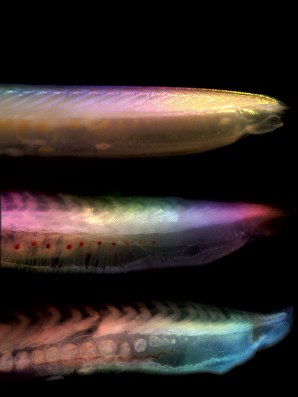
Palaeontologists in Leicester University are studying rotting lancelets in an attempt to explain something very fishy about the fossil record. Sarah Day explains...
Geoscientist online 1 February 2010
In a highly pungent experiment, University of Leicester palaeontologists have been using dead lancelets – specimens of the Cephalochordate
Amphioxus - to reconstruct the processes of decomposition, in a study funded by the Natural Environment Research Council (NERC).
By studying their decay, the researchers can get a clearer picture of what might have happened to ancient fish-like creatures as they rotted, prior to fossilisation - which in turn helps them to interpret fossil remains.
‘What we want to get at is what an animal was like before it died’, says Dr Rob Sansom, lead author of the paper. ‘As with forensic analysis, knowing how the decomposition that took place after death altered the body provides important clues to its original anatomy’.
The results of the study, published yesterday in the journal
Nature, show that characteristic features of early vertebrate fossils may have been lost during decomposition. This could mean rewriting our understanding of our earliest ancestors.
With characteristic features such as a tail, eyes, and the beginnings of a backbone, fish-like fossils from half a billion years ago represent part of our earliest ancestry.
‘These fossils provide our only direct record of when and how our earliest vertebrate ancestors evolved’ says Dr Mark Purnell, one of the leaders of the study. ‘Did they appear suddenly, in an evolutionary explosion of complexity, or gradually over millions of years? What did they look like? – in what ways did they differ from their worm-like relatives and how did this set the stage for later evolutionary events? Answers to these fundamental questions – the how, when and why of our own origins – remain elusive because reading the earliest vertebrate fossil record is difficult’.
This is largely because so many features of an organism’s anatomy are lost during the process of decay, although it could also suggest rapid, explosive evolution. Developing a better understanding of how decomposition happens will help to answer these questions. As Dr Sarah Gabbott, who with Dr Purnell conceived the study, explains: ‘Only in the most exceptional circumstances do soft-tissues, such as eyes, muscles and guts, become fossilised, yet it is precisely such remains that we rely on for understanding our earliest evolutionary relatives: half a billion years ago it’s pretty much all our ancestors had’.
The novel approach is not so surprising, as Dr Sansom explains: ‘Interpreting fossils is in some ways similar to forensic analysis – we gather all the available clues to put together a scientific reconstruction of something that happened in the past…as with forensic analysis, knowing how the decomposition that took place after death altered the body provides important clues to its original anatomy’.